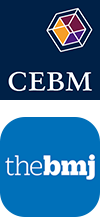




Dr Amy Price
The greatest gift Evidence-Based Health Care bestows is the power to critically appraise Health Science. I learned from Oxford that the most powerful teaching is that which we can put into daily practice and help others to do the same.
Sharing evidence requires building relationship and developing trust. We are taking others to a new place. They may be blind to knowledge and a little afraid. When we deliver the branch of knowledge we can share it like a lifeline or use it for a stick. When we beat with the stick of superiority, authority and argument the experience of evidence is avoided. Yet when we share evidence as discovery and answers, people everywhere seek it.
Evidence lives when it is delivered in bite-sized pieces where we are shown the recipe, the ingredients are made available and the learning we need is targeted and just in time. It helps when we say just enough. A great example is the single statement in the BMJ which asks, “Were patients or the Public involved in this research?” Prospective authors know that this is something they need to consider and it is up to them to find ways to do this. This one statement is more powerful than many warnings. The BMJ has also recently implemented patient reviewers to work side by side with traditional reviewers. You can join here.
In sharing about research knowledge we can stir the pot just by asking, “What evidence brought your thinking to this place? If it is good, we can encourage and multiply what is found and if it is faulty we can suggest alternatives and be ready to answer the whys.
It is evidently impossible for health and social care professionals in most fields to keep up to date with the torrent of high quality evidence now being published. The sheer volume of quality research is, of course, something very much to be celebrated, but if practitioners cannot absorb all of the important new knowledge, then patients do not benefit. Nor is it reasonable to demand that practitioners demonstrate continuous professional development without some way of navigating this sheer volume of research. [André Tomlin 2015]
The National Elf Service article, Mental health research: let us reason together #RCTdebate The elves and I co-authored acted as a vehicle to open doors of opportunity and understanding between academic researchers, clinical trial advocates. mental health service users and the public. There is still ongoing discussion and collaboration even five months later. The Elves were recently recognized by The Lancet for their work in the mental health community. You can attend the National Elf Service and BMJ pre-workshop to learn the best ways to communicate science and critically appraise a research paper.
0900-1700 Tuesday 21st June, Oxford
This fun hands-on workshop will equip you with the skills you need to:
Blogs and social media are an essential part of science communication and evidence-based practice in the 21st century. Find the best ways to use these tools to keep up to date with the latest reliable research and how to maximize your online impact.
Evidence Aid is at Evidence Live 2016 and was formed in 2004 to enable the reception of humanitarian aid in the most timely, effective and appropriate fashion and to inspire and enable those guiding the humanitarian sector to apply an evidence-based approach in their activities and decisions.
You can’t know when you will be faced with a disaster but now you know where to find practical [p]help. Evidence Aid offers lay friendly and professional level evidence for humanitarian disasters. During Hurricane Andrew, I worked with the Red Cross to bring relief. This was the most destructive hurricane to hit in the history of the USA. We were ill equipped. Untrained volunteers were left to improvise about what to do with armed gang members in shelters, domestic violence, supply shortages, and emergency medical care.
With an increasing demand for ‘value for money’, proof of impact, and effectiveness in the provision of humanitarian aid, it is essential to ensure that decisions and activities are evidence-based. This requires an agile organisation with a scientific approach to operate from a robust and responsive network. Evidence Aid collaborates to ensure an evidence centered application and they welcome volunteers, collaborators and end users.
“The job of the human being [in the digital age] is to become skilled at locating relevant valid data for their needs. In the sphere of medicine, the required skill is to be able to relate the knowledge generated by the study of groups of patients or populations to that lonely and anxious individual who has come to seek help” (Sir Muir Gray, 2001)
These organizations have bridged gaps to meet evidence needs for populations and individuals. They build the digital bridge while others still speak of the digital divide.
Cite as Price A (2016): Tools to Communicate Evidence so Others Can Own It CEBMJ /tools-to-communicate-evidence-so-others-can-own-it/ DOI: 10.13140/RG.2.1.4796.9688